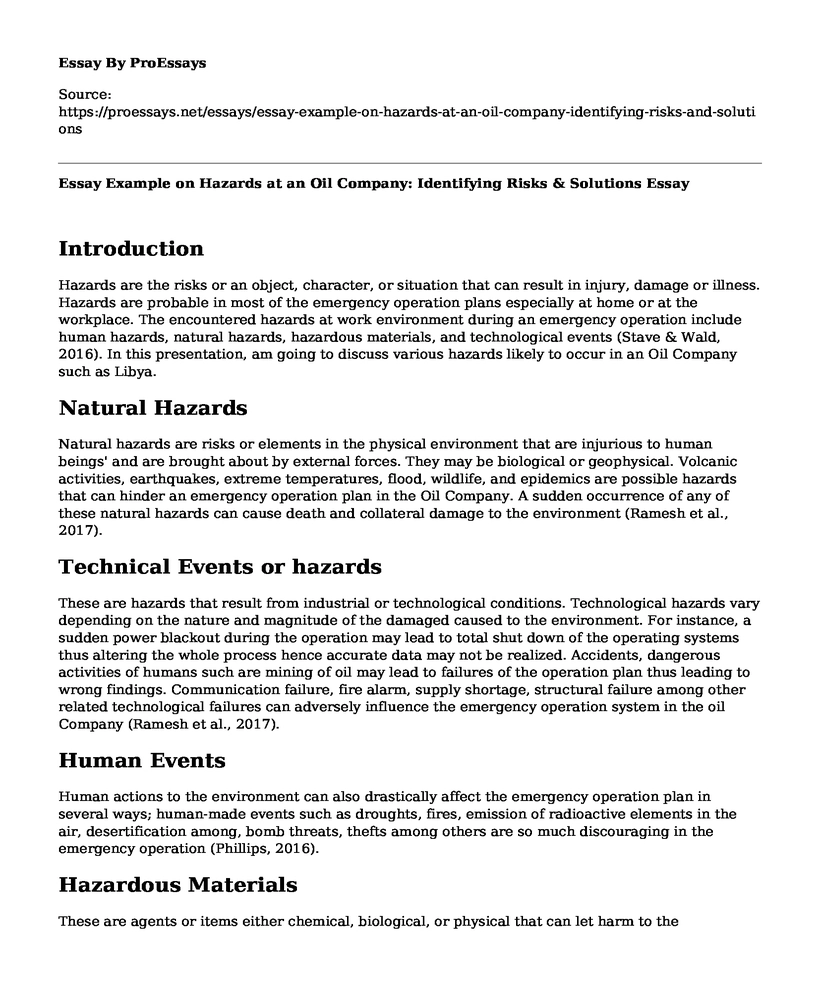Introduction
Hazards are the risks or an object, character, or situation that can result in injury, damage or illness. Hazards are probable in most of the emergency operation plans especially at home or at the workplace. The encountered hazards at work environment during an emergency operation include human hazards, natural hazards, hazardous materials, and technological events (Stave & Wald, 2016). In this presentation, am going to discuss various hazards likely to occur in an Oil Company such as Libya.
Natural Hazards
Natural hazards are risks or elements in the physical environment that are injurious to human beings' and are brought about by external forces. They may be biological or geophysical. Volcanic activities, earthquakes, extreme temperatures, flood, wildlife, and epidemics are possible hazards that can hinder an emergency operation plan in the Oil Company. A sudden occurrence of any of these natural hazards can cause death and collateral damage to the environment (Ramesh et al., 2017).
Technical Events or hazards
These are hazards that result from industrial or technological conditions. Technological hazards vary depending on the nature and magnitude of the damaged caused to the environment. For instance, a sudden power blackout during the operation may lead to total shut down of the operating systems thus altering the whole process hence accurate data may not be realized. Accidents, dangerous activities of humans such are mining of oil may lead to failures of the operation plan thus leading to wrong findings. Communication failure, fire alarm, supply shortage, structural failure among other related technological failures can adversely influence the emergency operation system in the oil Company (Ramesh et al., 2017).
Human Events
Human actions to the environment can also drastically affect the emergency operation plan in several ways; human-made events such as droughts, fires, emission of radioactive elements in the air, desertification among, bomb threats, thefts among others are so much discouraging in the emergency operation (Phillips, 2016).
Hazardous Materials
These are agents or items either chemical, biological, or physical that can let harm to the environment, animals or human beings through external or internal connections. For instance the items captioned ''Toxic, corrosive, explosive, poisonous, reactive or flammable'' are also considered hazardous to the environment. Prone hazardous materials within the oil Company may include huge metals, mercury, solvents of petroleum among other poisonous substances that may result in damages to the environment, and urgent operation plan.
Conclusion
This presentation summarizes the four environment hazards that may be experienced by workers in the emergency operation plan. They include natural hazards, human hazards, technological hazards, and hazardous materials that are harmful tom the work environment (Kivimak & Kawachi, 2016).
References
Kivimaki, M., & Kawachi, I. (2015). Work stress as a risk factor for cardiovascular disease. Current cardiology reports, 17(9), 74.
Phillips, J. P. (2016). Workplace violence against health care workers in the United States. New England journal of medicine, 374(17), 1661-1669.
Ramesh, R., Prabu, M., Magibalan, S., & Senthilkumar, P. (2017). Hazard identification and risk assessment in the automotive industry. International Journal of ChemTech Research, 10(4), 352-358.
Stave, G. M., & Wald, P. H. (Eds.). (2016). Physical and biological hazards of the workplace. John Wiley & Sons.
Cite this page
Essay Example on Hazards at an Oil Company: Identifying Risks & Solutions. (2023, Feb 20). Retrieved from https://proessays.net/essays/essay-example-on-hazards-at-an-oil-company-identifying-risks-and-solutions
If you are the original author of this essay and no longer wish to have it published on the ProEssays website, please click below to request its removal:
- Effect of EGR on the HCCI Engine Performance Using Biodiesel as a Fuel: Paper Example
- Essay Sample on Establishing a Strategic Leadership Team
- Risk Management in Healthcare Market: US ACA in Retrospect - Essay Sample
- Essay Sample on Global Expansion: Research & Considerations Before Taking the Plunge
- 21st Century Leadership and Management: Understanding Firm Success in Healthcare - Essay Sample
- Essay Example on Company Consolidates Staff for Chain Store Success in USA
- Understanding Production - Report Sample







